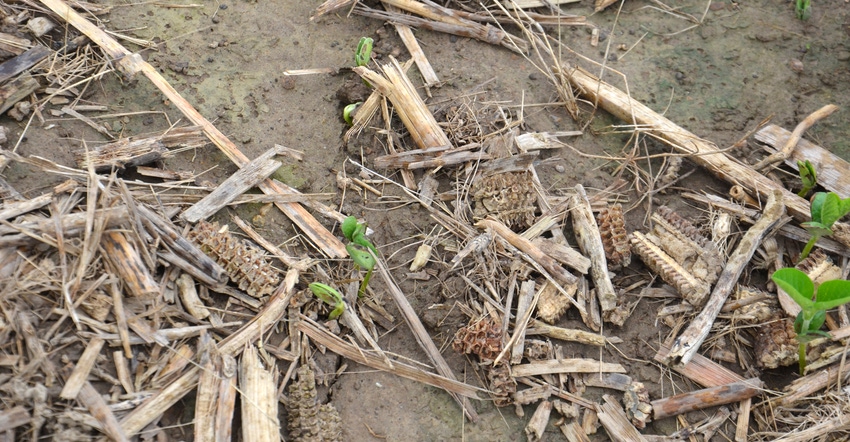
If scouting early is important in corn, Jeff Lakin believes it’s even more important for soybeans. “I typically start scouting soybean fields sooner after planting than I would in cornfields,” says Lakin, a technical agronomist for Channel Seeds. Based near Rensselaer, he covers northern Indiana.
Why is scouting earlier critical for soybeans? “There are more likely to be crusting issues that interfere with emergence,” Lakin says. “If you’re monitoring emergence, there is crusting and it appears soybeans may have a hard time breaking through it, you can make the decision to run a rotary hoe over the field to help break the crust and get more soybeans up.”
Corn emerges with the single-point coleoptile punching through the soil. While crusting can be an issue with corn, it’s generally tougher for soybeans, since the hypocotyl must pull the cotyledons through and above ground. The cotyledons were the original two halves of the soybean seed. If the hypocotyl breaks during the process of pushing through a crust, often referred to as “breaking its neck,” that plant is finished — it won’t grow. With corn, since the seed and growing point remain below ground at first, with the growing point emerging at about V5 or the five-leaf stage, if top leaves are damaged, the plant still can grow.
Steve Gauck, a regional agronomy manager for Beck’s, based near Greensburg, agrees that it’s important to scout early enough to assess if soybeans are encountering problems during emergence. Beck’s developed a simple “yes or no” survival guide growers can use when assessing early problem stands. The goal is to determine if an individual plant will survive and should be counted when making replanting assessments.
Here are six possible situations:
Plant is emerged but broken off below the cotyledons — plant will not survive
Plant is missing both cotyledons, but the growing point is still intact — plant will survive
Plant is missing only one cotyledon — plant will survive
Plant is broken off above the unifoliate leaves — plant will survive
Plant is lightly bruised on the stem — plant will survive
Plant is heavily bruised and broken over — plant will not survive
Determine stand counts
You may see plants missing for a variety of reasons, Lakin says. Seedling diseases can take plants out, including pythium, rhizoctonia and phytophthora. Bean leaf beetles are more likely to chew on foliage than chew off plants, and it takes a large amount of damage early in the season to justify spraying for bean leaf beetles. Black cutworm is usually considered a pest of corn, but black cutworm larvae can also cut off soybean plants, Lakin says.
Whether or not enough plants are missing to force replanting depends upon several factors, Lakin says. One of those factors is whether the remaining stand is relatively uniform.
He typically looks at a grower’s target population. If the goal was 130,000 plants per acre and he has 75% of a stand that is uniform, the best decision is likely leaving the stand, he says. For example, if your goal was 130,000 plants per acre and you have 90,000 to 100,000 plants per acre, and they are reasonably well distributed, you should still be able to achieve a good yield, he says.
Gauck has traditionally told growers they can live with 80,000 plants per acre if there aren’t huge gaps, assuming they can control weeds. Some more recent data indicates you might be able to go even a bit lower, he reports.
About the Author(s)
You May Also Like




